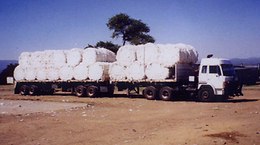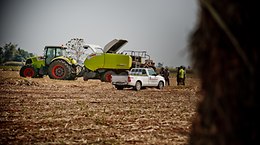

Different countries, different bales.
CLAAS balers were already used with 25 different crop types, such as:
grass - barley - sugar cane - peas - hay - wheat - kennef - field beans - oats - cotton - sunflowers - switchgrass - rapeseed - peanuts - sorghum - szarvasi - maize - rice - cup plant (silphium) - hemp - silver grass (miscanthus) - reed canary grass - flax - soybeans
Here are a few examples of these applications throughout the world:

3 hp for ROLLANT use.
If, like the Amish in the USA, you are prevented from using tractors for religious reasons, baling with the ROLLANT is still possible. A built-in motor drives the baler, and three horses ensure forward motion. This means the ROLLANT can be used successfully even here, with modern technology adapting to strict religious requirements.
The ROLLANT harvesting sugar cane.



In sugar harvesting, only the juicy stems are gathered. The CLAAS sugar cane harvester blows all leaves onto the field; usually, these leaves are left on the field to rot over time. In some regions, the leaves are collected by a ROLLANT and compressed into round bales. The remaining dry sugar cane turns into a combustible raw material, which is easy to transport and provides an additional source of income for the farmer.
Soft material in hard bales.
The plucked cotton must be transported from the field to the cotton factory for further processing. This can often involve long distances. The vehicles must be loaded as fully as possible. Baling up the cotton using a ROLLANT is the obvious solution. The otherwise loose and lightweight material can be transported economically over long distances, as here in South Africa.


Our QUADRANT balers are versatile, and are used in more than 100 countries and 100 different crop types worldwide.
The photos above show a QUADRANT 5300 baling switchgrass in Sudan. But there is an ever-increasing demand for the baling of biomass (this QUADRANT 4200 is baling sugar cane in Thailand).






